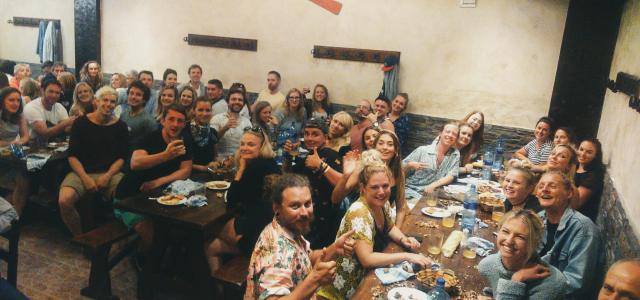
If you are looking for an epic night of fun, history, delicious food and unlimited drinks, a Cider House, Sidrería (Spanish) or Sagardotegi (Basque) is the place to go in the Basque Country.
This is more than just a restaurant, is a cultural and dining experience. If you happen to be in this area of Spain during the Cider season (January-May) a trip to a Sidrería is a must!

Basque cider or Sagardo is not like your usual sweet and bubbly cider. Sidra is made out of a natural fermentation of apple juice. No carbonic gas is added to the fermentation process, unlike most of other ciders around the world, resulting in a more acidic (not sweet at all) and less bubbly beverage. Some may say it has a distinguished vinegary flavour, which makes sense since the fermentation process is the same.
FUN FACT: If you let cider ferment for longer you can achieve apple cider vinegar.

A bottle of Satxota Cider, Sidrería Satxota, Aia (Guipúzkoa), Basque Country
Source: Haritz Satxota & Desirée Piña
The apples are harvested from September to November and the cider season officially starts in January, going on until the end of May. Nevertheless, there are a few share of cider houses that are open until the end of summer and even all year round.
Cider houses
Astigarraga, a small town located 15 minutes away from the city of San Sebastian is called the Capital de la Sidra or the cider capitol city because it has the most number of cider houses per capita in all of Spain. My personal favourites are Sidrería Petritegi in Astigarraga, Sidrería Satxota in Aia, Sidrería Iparragirre in Hernani and Sidrería Zapiain in Astigarraga.
A cider house is the place where cider is made and then usually stored in huge barrels, called Kupelas. Back in the days, people would bring their own food and enjoy drinking and tasting that years cider production.

Kupelas, Sidrería Satxota, Aia (Guipúzkoa), Basque Country
Source: Haritz Satxota & Desirée Piña
Today, these cider houses offer not only cider but a delicious set menu as well. There is usually a set price of 25 to 40 euros (depending on the Sidrería of choice) per person. This includes unlimited amount of cider and a set menu that is usually shared by your group in big wooden tables.
Starting with some chorizo a la Sidra, followed by tortilla de bakalao (cod omelette), grilled or confit cod with a typical Basque sauce (Pil Pil, Vizkaína, Piperrada) and some Txuleta (aged steak).

Txuleta, Sidrería Iparragirre, Hernani (Guipúzkoa), Basque Country
Source: Irene & Desirée Piña

Source: Irene & Desirée Piña
While you are pleasantly enjoying dinner with your friends and/or family you will randomly hear a very loud man screaming TXOTX (pronounced choch) at the top of their lungs. This mean, everyone stops what they are doing and head to the Kupelas or barrels of cider.
A barrel is open, a lined is formed and sidra starts pouring out. There actually is a correct way that you need to catch the cider: from a distinct angle and distance. This is done in order to open the air particles in the cider and which makes the flavour and texture optimal. You should pour a little bit of sidra at a time and is usually drank on the spot.
Remember, this goes on randomly throughout the whole night. So be prepared to drink the night away!

Kupela, Sidrería Satxota, Aia (Guipúzkoa), Basque Country
Source: Haritz Satxota & Desirée Piña
Back to the table and the the king of the night is served. A huge piece of Txuleta (grilled aged steak) is cooked to perfection (maybe too raw for your taste but you can always order to cook it more and they will happily do so) and served in the middle of the table in order for you to indulge.

Dessert consists on an assortment of Basque cheeses, quince jelly and walnuts. Even though you will usually be provided with a nutcracker it is common between male Basque friends to crack the walnuts with their forehead.
Do not be alarmed if you see people crushing their heads in the table in the middle of the night. Most will succeed, many others, specially giris or tourists will go back home with a bloody scar in their forehead.

Source: Desirée Piña
We are coming to San Sabastion in mid May. What are the hours for the restaurant and do we need reservations?